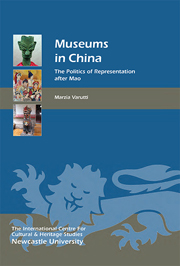Book contents
- Frontmatter
- Contents
- List of Illustrations
- Acknowledgments
- Chronology
- List of Abbreviations
- Introduction
- 1 Cultural Heritage in China
- 2 Museums in China: origins and Development
- 3 New Actors in the Chinese Museum World
- 4 Museum objects and the Chinese nation
- 5 The nation in the Museum
- 6 The Politics of the Past
- 7 The Representation of the Past in China's Museums
- 8 The Politics of identity
- 9 The Museum Representation of ethnic Minorities
- 10 Techniques and sites of Display of ethnic Minorities
- Conclusions: The new Museums of China
- Appendix: List of Museums in China Visited by the Author
- Bibliography and References
- Index
- Heritage Matters
2 - Museums in China: origins and Development
Published online by Cambridge University Press: 05 March 2014
- Frontmatter
- Contents
- List of Illustrations
- Acknowledgments
- Chronology
- List of Abbreviations
- Introduction
- 1 Cultural Heritage in China
- 2 Museums in China: origins and Development
- 3 New Actors in the Chinese Museum World
- 4 Museum objects and the Chinese nation
- 5 The nation in the Museum
- 6 The Politics of the Past
- 7 The Representation of the Past in China's Museums
- 8 The Politics of identity
- 9 The Museum Representation of ethnic Minorities
- 10 Techniques and sites of Display of ethnic Minorities
- Conclusions: The new Museums of China
- Appendix: List of Museums in China Visited by the Author
- Bibliography and References
- Index
- Heritage Matters
Summary
The Historical Development of Museums in China
The notion of the museum as a public institution has a relatively short history in China, having been imported by the colonial powers Great Britain, France and Japan. Indeed, ‘Asian nations are still struggling, with mixed results, to domesticate this somewhat exotic transplant’ (Kahn 1998, 226). Referring to museums in early 20th-century China, the Chinese museologist Guo Changhong (2008, 80) notes that, in China, the museums of the time were frequently viewed as ‘imported wonders’. The effort to educate the Chinese people, safeguard cultural artefacts and promote research through museums can be directly attributed to an increasing acceptance of Western ideas in early modern China, as well as to the institutional transformations Chinese society underwent in the wake of the Revolution.
In the evolution of museums in China, three phases can be identified. The first phase is associated with forms of proto-museums, such as the Temple of Confucius. Although Chinese museology considers these to be the origins of the institution, strictly speaking, museums did not appear in China until the second half of the 19th century. The establishment of the first museum open to the public, in 1868, marked the dawn of a second phase in the history of Chinese museums. The spread of museums accompanied the transition from the imperial to the republican system, as marked by the emblematic transformation, in 1925, of the Imperial Palace (Forbidden City) into a public museum.
- Type
- Chapter
- Information
- Museums in ChinaThe Politics of Representation after Mao, pp. 25 - 42Publisher: Boydell & BrewerPrint publication year: 2014



